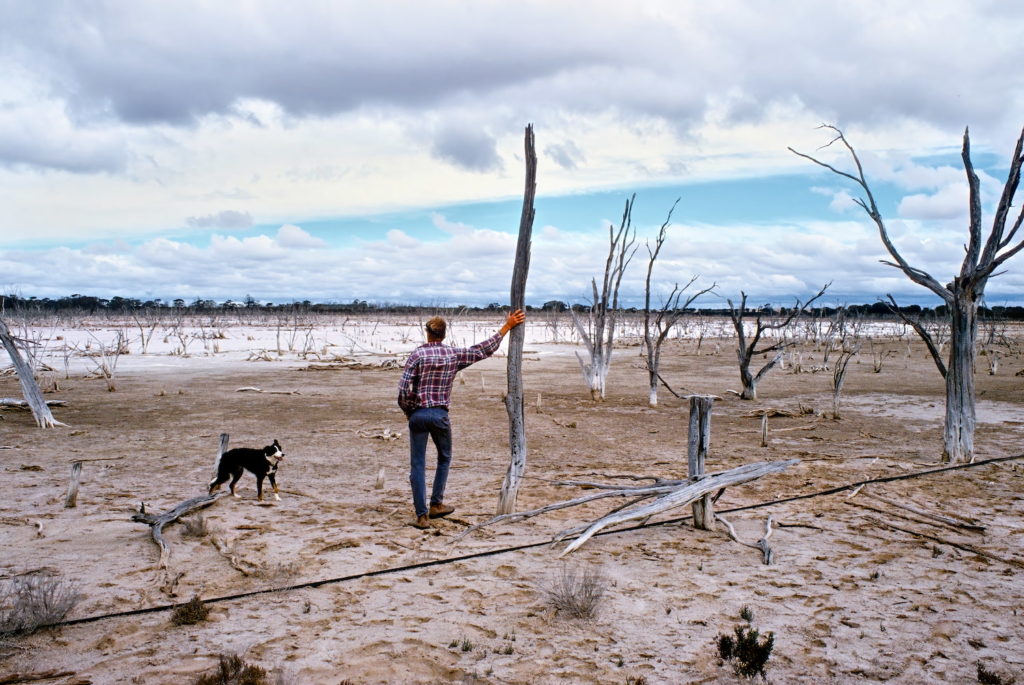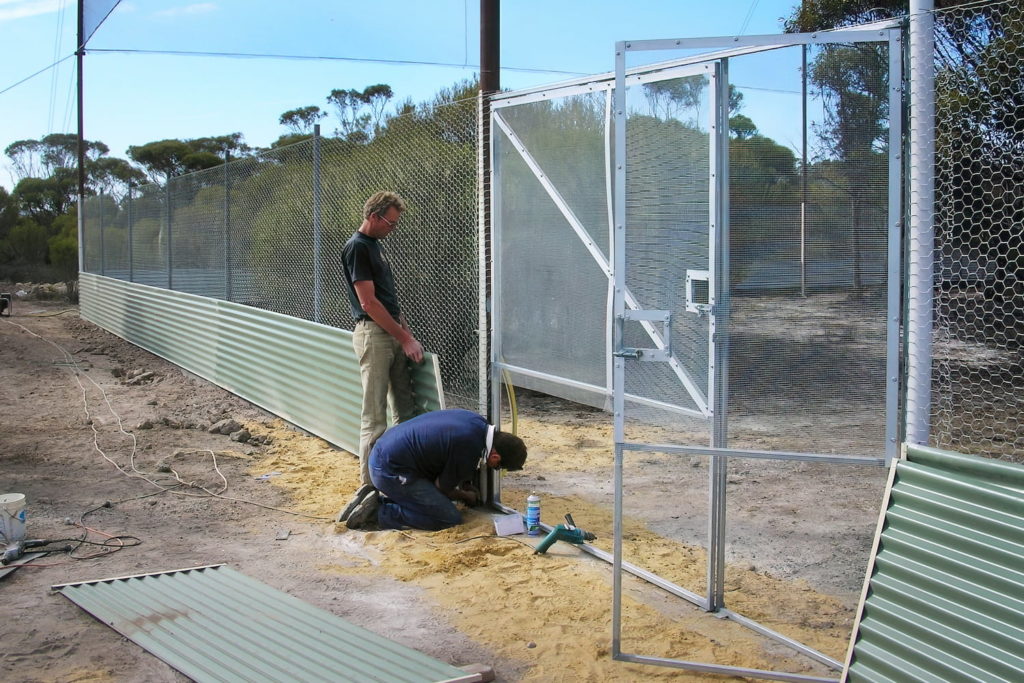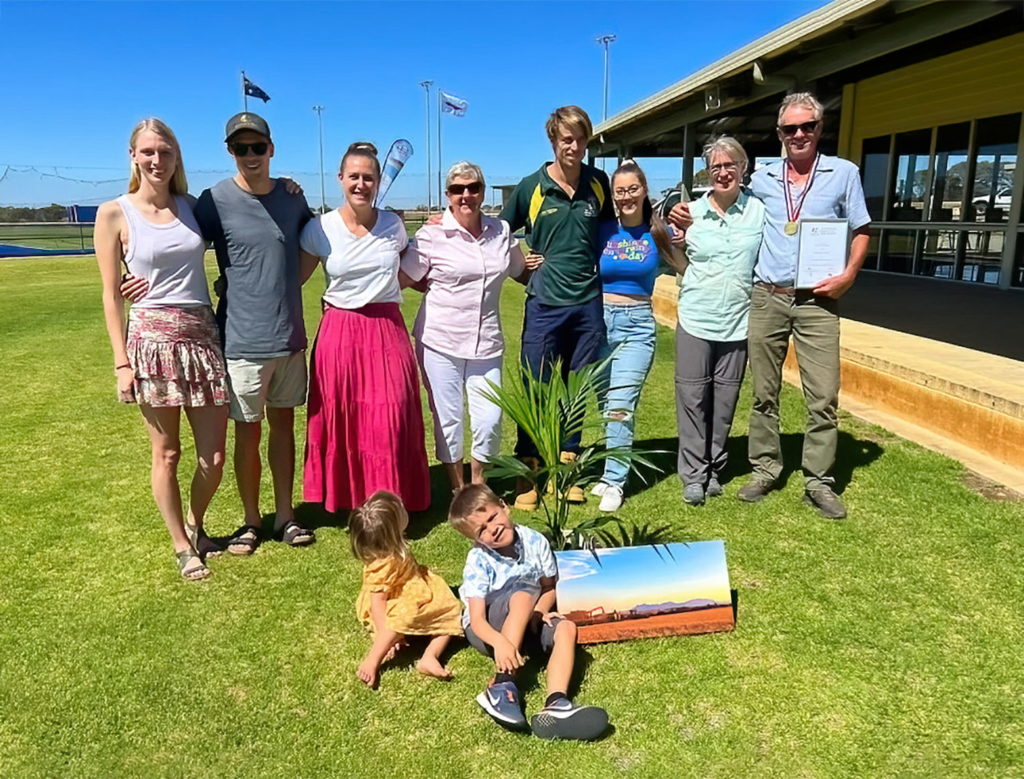Farming family maintains a landcare tradition
Kingsley Vaux, Shire of Gnowangerup’s Citizen of the Year for 2023, is a leader in landcare and has played key roles in establishing the Yongergnow Malleefowl Centre and reviving the Ongerup General Store. His mother Kaye set the scene with her passion for the bush and Ongerup. Here’s Kingsley with Bill Bunbury OAM, digging deep on the need for a landcare ethic and what it takes to keep a small rural community on its feet.
Bill: How important is the connection between the community and conserving and repairing land?
Kingsley: Caring says it all, doesn’t it? If you care for your community, you’re probably caring for your environment as well. A few people are more involved than others in landcare, and I feel that the younger ones are probably not so conservation-minded because they’re no longer surrounded by the bush, whereas us older ones were. We grew to love the bush and its beauty and its animals and have a love for nature.
Bill: How far back does that bush connection go?
Kingsley: My paternal grandparents started farming on a bush block at Ongerup in 1913. My maternal grandfather was farming in the Porongurups before the war. He knew the bush between the Stirlings and the Porongurups, and my Mum, Kaye née Faulkner, grew up on that farm. Her younger years in the bush influenced her and she certainly influenced me growing up in the bush in Ongerup.
In the late 1940s, after she married my Dad and moved to his family’s Ongerup farm, she was one of the instigators of the local cubs and scouts. Often, we’d take everyone and go camping overnight in the bush and learn about nature — it was a pretty momentous time. It was very influential for me as far as conservation goes — realising what’s going on around you.
I had a wonderful childhood. Noongar people, mainly the Woods family, worked on the farm and lived down the road. Up to 17 of us used to get on the school bus. During the weekends I’d go off with all the Noongar kids and we’d go duck hunting and swim through the lakes and dams, climb trees to collect eggs and check out where to find all the different bird nests; we’d listen for all the calls and recognise them.
We had a lake right next to the house and normally we’d jump off the school bus, run through the kitchen, grab a vegemite sandwich and straight out to the boat and onto the lake, harassing the swans — a great childhood.

Bill: With the massive land clearance of the 1950s and 60s, during some of your childhood years, there would have been a lot of people who started to farm for the first time. How did that influence the way they handled the land?
Kingsley: A lot of the people who took up bush blocks in the 50s and 60s came from all walks of life. The government issued them land and they had to clear it. And if they didn’t, it was taken off them. They went in not knowing too much about it, but everyone communicated and visited each other in those days, and they eventually learned. But a lot of mistakes were made, and I believe the massive clearing with large bulldozers in the 50s and 60s was wrong. I wish we hadn’t done a lot of that.
Bill: How did you improve the land you are now farming and living on?
Kingsley: When I came home from boarding school in the early 70s, salinity was a big issue. I’ve tried to stop it. I planted my first 400 trees a few years later, when I came home from ag school, but nearly all were eaten by grasshoppers. We had another go the next year and it was quite successful and it went on from there. Since the 80s, my wife Sandy and I have direct seeded native species on the farm – it’s been a learning curve. We’ve largely done all the windbreaks and boundary plantings we wanted to do and now we’re mostly direct seeding along creek lines, and sowing sandalwood plantations.
We had a very, very enthusiastic landcare ethic in the 80s and 90s, including fox baiting, and I was a member of the Landcare committee at the time (and for another 43 years!). There were a lot of people participating in tree planting and trying to fight this salt. We were losing a football field a year across the six to seven thousand acres of our land, and we had to do something about it. The work that we did with planting trees, lucerne establishment and conservation farming helped us manage the salt.

We put in piezometers to measure the water table and as the dry years came in the 90s, we thought we were very successful in dropping the water table, but it was actually a lot to do with the rainfall. It was only with the trees and the reduced rainfall that we stopped the salinity.
Our landcare meetings were packed and there was no problem getting committee members. Everyone was interested because everyone was worried about what was going on, mainly with the salinity. And, of course, when the area started blowing away due to land clearing and overstocking, that was horrific and heartbreaking to see.
We had numerous field days on saltbush and trees and methods of planting trees. Sandy was the first Landcare Officer out at Jerramungup when they started up Landcare in that district.
The young people who are now caretakers of the land, caretakers of the farm, they haven’t got the natural places to go that I had. They didn’t have the childhood that I did, where they’re playing in the bush and seeing the animals. It’s difficult to pass that legacy on. My kids certainly do have respect for the land but I know there’s a lot who are after the most efficient way to put a crop in. One of my friends described it as industrial farming — not able to use a steering wheel to go around the remaining trees. I can understand why they want to get rid of some paddock trees because, when you’re seeding the crop, it is very uneconomical to stop the fertiliser, drive around and come back into line, but there’s still plenty of room for revegetating the creeks. You might as well have 80% of your farm running at 100% than 100% running at 80% — I do believe that the trees and having the birds and insects is pretty vital, especially for canola and all those things that flower.
But everyone chases the dollar — that’s why they’re out there farming. So we’ve always said, we need to make landcare pay and prove it. We’ve planted sandalwood which looks like it’s going to pay when it’s harvested. And society needs to come up with a way of carbon farming so if you have a bad year, you’re still going to get $15 or $25 a hectare; it’s going to come in every year because you are looking after nature.

Bill: One advantage of country life is that it’s also community life. Do you think that’s ultimately the key as to whether you sustain things or not?
Kingsley: I’m getting older so I guess I don’t socialise as much, but the community side has disintegrated since its heyday years, in that everyone’s gone inward – and COVID hasn’t helped. We don’t seem to have as many community events or get out and talk as much. There used to be a lot more sport, like tennis, and little gatherings to play cards and talk around the table.
My boys now drive 160 km return at least once a week to get to footy training at Boxwood Hill. That’s part of not having so many people around — our population is decreasing all the time. But also, people are too busy with their larger land holdings. In years past, if you saw a neighbour while you were driving around the boundary, you’d back up and have a chat. Now you just gesture ‘g’day’ with a finger and keep driving.
So it is harder to sustain landcare — it’s very difficult to get staff, to get committee members. The local Landcare group is branching out and trying to get the young ones interested in all the things that are relevant to farming, not only the landcare projects, and then trying to introduce the landcare ethic. But it’s difficult to get people to come along to a field day unless you’ve got something brand new and exciting.
The Yongergnow Malleefowl Centre in Ongerup was dreamt up on the environmental side — looking at us through the eyes of the malleefowl. The initial feeling was we needed something to get some outside money into town because agriculture alone is not going to sustain a little town, so we wanted to get tourism going. It struggled initially, but it’s one of the bigger employers in town now — it’s the town hub.

We wanted to focus on the malleefowl and conservation, which has a long history in this area through the Ongerup Conservation Group, which Mum was very active in, and the Malleefowl Preservation Group, which was the passion of my sister Susanne Dennings. So that conservation story is told in the Malleefowl Centre along with the story of the Ongerup district from traditional Noongar times right through. And now we’ve got the cafe in there and the Community Resource Centre and it’s doing really well.
We have captive malleefowl in a large, fenced enclosure so visitors can see the parent birds tending their malleefowl mound. Elder Eugene Eades brings groups up from Nowanup to see Yongergnow and he also brought along university students to help establish the Native Foods Garden for visitors.
Here’s another great example of the importance of community life. Unfortunately, in about 2012 we lost our Ongerup General Store. It was a fantastic store for many, many years. But through poor management by the previous owners, it went broke and the bank took it off them — it was closed for 18 months.
Just prior to that we also lost the local football team. And there was just nothing happening in the town, it was absolutely horrible. But we knew we deserved the shop. We had supported a shop for so long. So a large group of farmers and townspeople got together. We bought it off the bank at a good price and there was a local guy who had a chemical farm business who wanted to expand and that was perfect. And we helped him get that going with a low rental, as long as he got the grocery store going. The whole town came and helped. We did a busy bee and cleaned it up. And within 18 months, he had the confidence to buy it back off us. He’s running it now and it’s a thriving little shop. And we’ve got people back into town. Thanks to Mick Creagh and his family who own it — they’re doing a great job.
Both Yongergnow and the General Store show that this community can sustain good things – it just takes a lot of work!
We’ve had a run of good years since about 2012-13. And with that we have seen an increase in younger people coming back to farms because it’s a financially viable business. Prior to that I didn’t think I was going to get any of my three home and now I’ve got all three back, so that’s really exciting.
What my Mum and Dad did with landcare rubbed off on me and I hope I’ll have some influence on how my kids run the farm. And hopefully they’ll continue the conservation work.
Bill: So are you positive about the future?
Kingsley: The good years are boosting the population in the small towns and it’s really good to see some of the younger ones actually coming back.
But even when I was a kid, I noticed the environment and the health of the bush. I could see the degradation. And it hasn’t slowed down. To actually survive and live on this planet well, everyone is going to have to be involved in this because they’ll have no other choice.
It’s a bit scary because we know the scientists are saying we’re nearly over the edge. I’m fighting for my grandchildren — it’s probably not going to affect me but I’d hate to see the world in another 80 years. I believe that with even the tiny little bit that I do, I can say, well, at least I tried. And I think everyone’s got to do that; everyone needs to step up.

THANKS to Kingsley and Sandy Vaux, Bill Bunbury OAM, Jenny Bunbury, Caroline House, Marg Robertson, Keith Bradby, Carol Duncan, Stephen Mattingley and the photographers.
